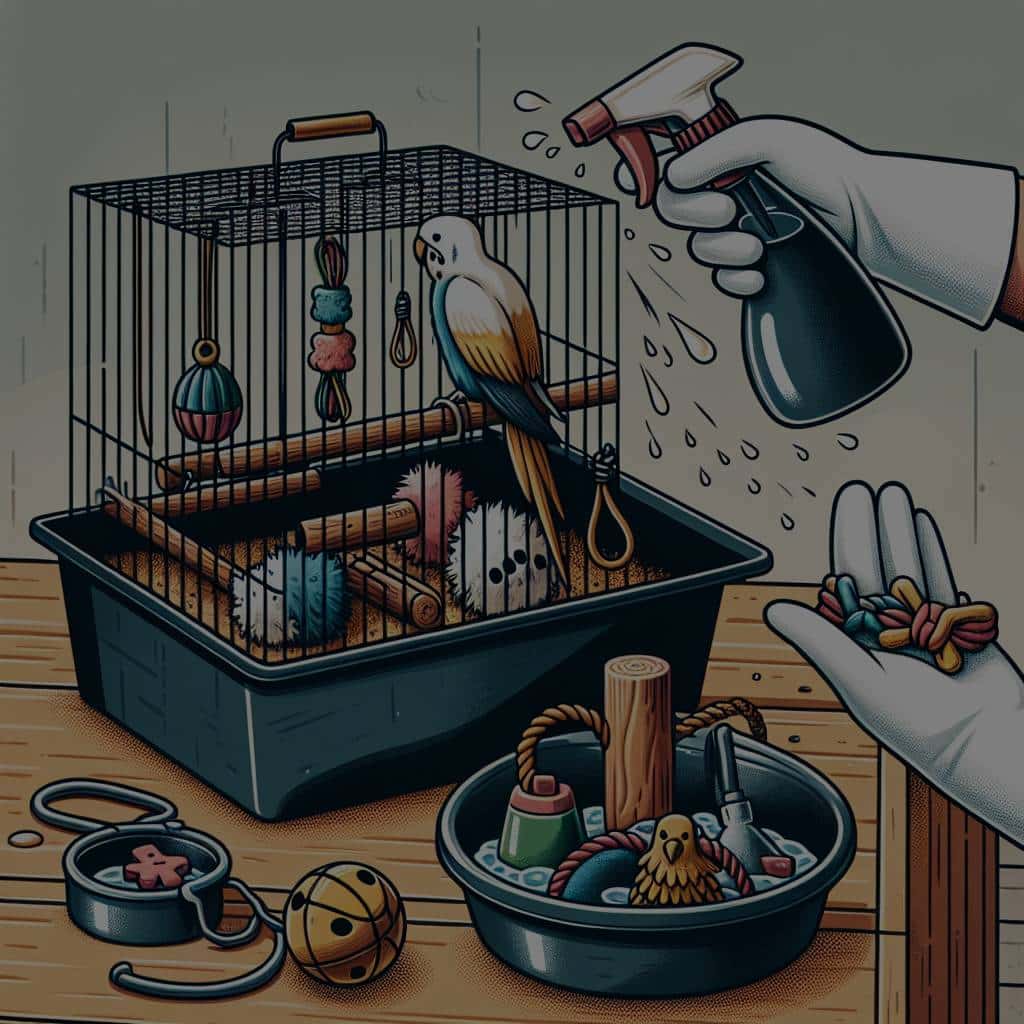What’s the Most Effective Way to Clean and Disinfect a Pet Bird’s Cage and Toys?

Birds are delightful creatures that bring joy and color to our homes. But to keep these feathered companions chirping happily, a clean and hygienic environment is crucial. As pet owners, safeguarding the health and welfare of your birds is non-negotiable. An essential part of this process is keeping their cage and toys clean and disinfected. This article will guide you through the best and most effective techniques of cleaning and disinfecting a bird’s cage and toys.
Understanding Why a Clean Cage Matters
The first step to understand the importance of a clean bird cage is to comprehend the risks associated with a dirty one. Birds, like all living creatures, are susceptible to a variety of illnesses, many of which can be contracted from unclean surroundings. Consequently, a dirty bird cage is a breeding ground for harmful bacteria, fungi, and parasites.
Sujet a lire : How to Train an Older Dog to Use a Ramp for Entering and Exiting Vehicles?
In the confined space of a cage, birds are in constant contact with their droppings and any food or water spills. If not cleaned regularly, these can develop into toxic molds or bacteria, potentially causing severe health problems for your feathered friends. Their toys, often forgotten, can also harbor these harmful elements. Regular cleaning and disinfection of cages and toys are hence imperative to prevent such issues and ensure the health and happiness of your birds.
The Best Way to Clean a Bird’s Cage
Cleaning a bird’s cage is more than just a cursory wipe-down. It requires a systematic approach and attention to detail to ensure that every nook and cranny is thoroughly cleaned. Here’s how you can do it:
Avez-vous vu cela : How Can You Prevent Your Cat from Overgrooming Due to Anxiety?
First, remove your bird and place it in a safe and clean temporary cage. Remove all toys, perches, dishes, and other removable elements from the cage. Dispose of any waste, leftover food, and water.
Then, clean the cage with hot, soapy water. Scrub all surfaces, including the corners, bars, and the bottom tray, making sure to remove any visible dirt or grime. If there are stubborn spots, use a non-abrasive scrubbing pad.
Rinse thoroughly with hot water to ensure all soap is removed. Soap residue can be harmful to birds. Then, dry the cage completely. A wet cage can develop mold and become a hotbed for bacteria.
Disinfecting a Bird’s Cage
After cleaning, it’s time to disinfect the cage. This step eliminates bacteria, parasites, and viruses that might be lingering in the cage.
Here, the best and safest option is to use a bird-safe disinfectant. These are specifically designed to be non-toxic and safe for birds, yet effective in killing harmful pathogens.
Spray or wipe the whole cage with the disinfectant, making sure to cover all surfaces. Then, let it sit for the recommended time on the disinfectant label before thoroughly rinsing with hot water. Again, drying the cage completely is fundamental to prevent microbial growth.
Cleaning and Disinfecting Bird Toys and Accessories
Bird toys, perches, and dishes can also harbor bacteria and should hence be cleaned and disinfected regularly. Remove all toys and accessories from the cage and dispose of any waste.
Wash them in hot, soapy water, scrubbing well to remove any dirt or bird droppings. Rinse thoroughly with hot water and dry completely.
Next, disinfect the toys and accessories using a bird-safe disinfectant. Be sure to follow the product instructions for effective results. Rinelyrinse with hot water, and then let them air dry before returning them to the cage.
Incorporating Routine Cage Cleaning into Your Schedule
Regular cage cleaning should be a part of your bird care schedule. Daily tasks can include removing food and water dishes and cleaning them, as well as removing any waste or droppings from the cage floor.
A full cage cleaning, including scrubbing and disinfecting, should be done weekly. This schedule can vary based on the number of birds, the size of the cage, and the specific species of your bird.
Remember, a clean cage is not just about aesthetics. It’s a crucial element to ensure the health and happiness of your pet bird. So, make sure to send the right messages to your pet bird by maintaining a clean and hygienic environment for them.
Incorporating these steps into your routine will ensure that your pet bird’s cage and toys are not just clean, but also safe and free from harmful germs. And remember, in the end, a healthy bird is a happy bird!
Choosing the Right Cleaning Products for a Bird Cage
Selecting the right cleaning products for your bird cage is an important factor in maintaining its cleanliness and hygiene. To ensure a thorough cleaning, there are specific products and tools you might need. A scrub brush with stiff bristles is useful for scrubbing away grime and dirt on the cage bars, while a toothbrush can be used for corners and smaller spaces.
When it comes to cleaning solutions, hot, soapy water is usually enough for regular cleaning. You can use mild dish soap, but remember to rinse thoroughly to avoid any residue, which can harm your bird. Additionally, avoid using scented soaps as birds have delicate respiratory systems and can be sensitive to strong smells.
After washing with soapy water, you need to disinfect your birdcage. It’s important to use a bird-safe disinfectant to eliminate potentially harmful bacteria and pathogens. These products are designed to be non-toxic to birds, yet effective in killing bacteria and other harmful microorganisms.
Remember to always follow the manufacturer’s instructions on the disinfectant label. Let the disinfectant sit for the recommended time before thoroughly rinsing with hot water. Once again, make sure to dry everything completely. Wet surfaces can encourage mold growth, which can be harmful to your bird.
Conclusion: The Importance of a Regular Cleaning Schedule for Your Bird’s Health
Keeping your bird’s cage and toys clean is not just about maintaining a neat and tidy appearance; it’s about ensuring the health and happiness of your pet. A clean cage minimizes the risk of exposure to harmful bacteria, parasites, and fungi that can lead to a variety of health issues in birds.
Integrating a regular cleaning schedule into your routine is an essential step in bird care. This includes daily tasks such as cleaning food and water dishes and removing waste, and a weekly deep clean and disinfection of the cage, toys, and accessories. This routine might vary depending on the number of birds, the size of their cage, and their specific species.
Remember, the end goal is to keep your bird happy and healthy. An effective way to do this is by maintaining a clean and hygienic environment for your bird to live in. After all, a clean bird, a clean birdcage, and clean bird toys contribute to a healthier and happier pet.
By following these guidelines, you’re not only ensuring a pleasant environment for your bird but also promoting its overall health and well-being. Remember, a clean and disinfected cage is a significant step towards a happier and healthier bird.
